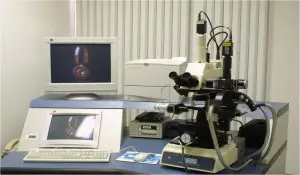Here’s something that the ATF has done that we all can applaud and support: it honored Allegheny County, PA (think Pittsburgh) for making a 2,500 “hits” in the NIBIN ballistics database.
According to the Federal Law Enforcement Officers’ Association (FLEOA) website FedAgent.com, Pittsburgh SAIC Sam Rabadi of ATF presented a plaque to the county for the county Medical Examiner’s Office’s Firearms and Toolmarks Section near-record “hit count.” A “hit” is a match between an investigational projectile, casing or toolmark, and one in the National Integrated Ballistic Information Network (NIBIN). This lets investigators match recovered guns to unsolved (or solved) crimes, to determine which of multiple shooters fired wounding or fatal gunshots, to support prosecutions and even to clear innocent suspects.
NIBIN is less used in ATF’s pursuit of paperwork violations and technical crimes, but is crucial to Federal and local cops in solving violent crimes. Rabadi noted, “NIBIN is instrumental in linking shooting incidents from recovered ballistics evidence in efforts to identify and remove violent trigger pullers from our neighborhoods.”
County Executive Rich Fitzgerald notes that only New York and Chicago have recorded more hits in NIBIN than Allegheny County. Maybe it’s because they’re gun-free zones?
Let’s Get Down to Cases, or One Case

Arika Hainsworth’s murderer was brought to justice thanks to ballistics evidence. Her sons have that, at least.
While the ATF release, the FLEOA release, and the county release all celebrated the achievement, none of them records the actual benefit of a specific case. Here’s one to consider. The 2011 Arika Hainsworth case was a tragic event: a police-gang shootout, with multiple shooters on both sides spraying 40 or more shots, left a 21-year-old mother of two young boys dead of a single gunshot wound. The police insisted the shooter must have been a gang member, because the police aimed their shots. “Community Organizers” insisted the shooter must have been a cop, because racism.
As Dr Karl Williams, the county ME, put it, “The obvious question with multiple guns being fired is what was the origin of that bullet? What gun did it come from?”
Because of the relative position of the criminals (second floor, shooting down and through windows) and the angle of the bullet that killed Ms Hainsworth, the slug was probably from one of the gangbangers. Spectrum analysis matched glass powder on the slug’s nose with the crime scene windows. Then, the bullet’s distinctive marks were compared to the guns recovered from the gangbangers, and the guns used by the police.
Hit. That hit identified the murder weapon exactly, and put one Amir Ferguson behind bars, convicted by a jury of his peers of Arika Hainsworth’s murder. Now this was a local hit and could have been done without NIBIN, but imagine if the Pittsburgh PD hadn’t caught Ferguson and recovered his gun on this scene, but six months from then he got bagged on a traffic stop in Johnstown. He’d go into the system there for gun possession — until his gun was compared to ballistic evidence in open and closed criminal cases, using NIBIN.
In the current budgetary environment, the ATF and Congress have been cutting back on NIBIN, in part because the proprietary workstations installed in the 1,000-odd NIBIN client agencies cost the agency a lot of money to maintain. Yet this is the sort of basic blocking-and-tackling of police work where ATF resources can, as SAIC Rabadi notes, lay the long arms of the law on those bad-guy trigger pullers and lock them up, with cases built on solid physical evidence. Senior ATF leaders prefer to conduct high-profile, press-oriented stings and short-term undercover operations (although they do a crappy job of backing up their UCs when they come in from the cold). But here’s an ATF operation that ought to be a no-brainer for the agency’s leaders and the agency’s sometimes opponents in the gun culture and industry to join hands and support.
ATF’s PR flacks, who spend most of their time writing reports for the handful of reporters willing to be spoon-fed that way (Richard Serrano, LA Times, come on down!) really missed a chance to use this presentation to highlight some of the actual violent crimes solved by NIBIN hits.

Kevin was a former Special Forces weapons man (MOS 18B, before the 18 series, 11B with Skill Qualification Indicator of S). His focus was on weapons: their history, effects and employment. He started WeaponsMan.com in 2011 and operated it until he passed away in 2017. His work is being preserved here at the request of his family.


4 thoughts on “ATF, Ballistics, and a plaque to be proud of”
FYI, from this source (http://www.justice.gov/oig/reports/ATF/a0530/intro.htm), “The cost of a complete RDAS [remote data acquisition station] setup is about $250,400. As of January 28, 2005, the NIBIN program had 216 RDAS units.”
I was curious because in my day job, I teach histology using an Olympus BX51 top-of-the-line research microscope, which complete with a top of the line DP71 camera and cellSens imaging software cost $37,000 in 2007 prices.
Cost-wise I’m especially suspicious of that built-in ‘workstation’ with 1970’s Wang styling, even taking into account there are differences (the RDAS has a projectile mount, mine has multiple objectives, it grabs longitudinal and transverse images, mine has fluorescence microscopy, Nomarsky optics, phase contrast and polarizing microscopy features built in). It seems to me like another winner for a Proxmire ‘Golden Fleece’ award – specially built by a company for only the government, at government prices. And our scope can get a lot more resolution than their photos suggest, down to half-wavelength (0.3 micron) 2-point discrimination.
Why can’t these things be purchased with off the shelf parts? This is not the heretofore unimagined USS Virginia we’re talking about building.
Hognose
Dunno. The NH State Police system has two Leica digital microscopes. I have no idea what it cost.
Bill: I suspect you are right that it is rather overpriced, but I went to the site forensictechnology.com and I am guessing that there is probably a fair amount of software behind the whole thing. That’s what gets expensive to produce. Today’s programmers can develop stuff a lot quicker and cheaper, but back when I’ll bet it cost the company a bundle when they first started. If Hognose is close to the mark and with only a thousand units (or so) of the hardware/software, the price is going to be high to make a profit covering the initial development of the software. Maintenance/upgrades of the software are likely a separate contract. I also see they have developed newer 3-D versions of their systems, so they must be doing reasonably well. So I don’t know if it is overpriced, but if it is a government contract, I tend to follow your thinking.
Appears that you have a sweet set-up. With my radiation background, I’m kind of partial to electron microscopy, but would love to play with your toys sometime. Guns are fun, but scientific tools are even more so.
While the ATF release, the FLEOA release, and the county release all celebrated the achievement, none of them records the actual benefit of a specific case.
One ponders why. Very briefly. Then barber Occam finishes with the soapy brush, and begins his work.
Now this was a local hit and could have been done without NIBIN, but imagine if the Pittsburgh PD hadn’t caught Ferguson and recovered his gun on this scene, but six months from then he got bagged on a traffic stop in Johnstown.
Imagine? Not good to extol something on imagination.
The demand for microstamping and other intrusive backdoor registration techs is driven by the fantasy that some significant portion of crimes are committed with guns that are then capable of being reliably tied by those techs to both the incident and the criminal at some (not too) later date. And that the link would not have been made otherwise. The evidence for this remains an exercise in “imagine if”, even when a “record breaking number of ‘hits’” is being discussed.